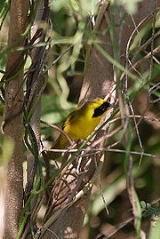
Altamira Yellowthroat
Encyclopedia
The Altamira Yellowthroat, Geothlypis flavovelata, is a New World warbler
. It is a resident breeding bird
endemic
to the Gulf slope of northeastern Mexico
.
It is closely related to Common Yellowthroat
, Belding's Yellowthroat
, and Bahama Yellowthroat
, with which it forms a superspecies. It has been considered conspecific with these species.
The Altamira Yellowthroat is 13 cm long and has a yellow-green back and bright yellow belly. The adult male has a black face mask and yellow crown. Females are similar, but lack the black mask and have an olive crown. This species is easily distinguished from wintering
Common Yellowthroats by its uniform yellow underparts, in contrast to Common’s white belly. Males' yellow forehead bands are diagnostic.
Vocalizations are very similar to those of Common Yellowthroat, and are not readily distinguishable to the human ear. Altamira and Common Yellowthoats, however, do not respond to tapes of one other’s songs.
The species is resident in freshwater marsh
es (including canals and drainage ditches), especiaally those with cattails. Little is known of its breeding or feeding habits, but other yellowthroat
s build a cup nest low in vegetation and feed on insect
s, usually captured in dense vegetation, so it is likely that Altamira Yellowthroat does the same. There has been a decline in numbers of this localized bird due to loss of habitat.
New World warbler
The New World warblers or wood-warblers are a group of small, often colorful, passerine birds restricted to the New World. They are not related to the Old World warblers or the Australian warblers....
. It is a resident breeding bird
Bird
Birds are feathered, winged, bipedal, endothermic , egg-laying, vertebrate animals. Around 10,000 living species and 188 families makes them the most speciose class of tetrapod vertebrates. They inhabit ecosystems across the globe, from the Arctic to the Antarctic. Extant birds range in size from...
endemic
Endemic (ecology)
Endemism is the ecological state of being unique to a defined geographic location, such as an island, nation or other defined zone, or habitat type; organisms that are indigenous to a place are not endemic to it if they are also found elsewhere. For example, all species of lemur are endemic to the...
to the Gulf slope of northeastern Mexico
Mexico
The United Mexican States , commonly known as Mexico , is a federal constitutional republic in North America. It is bordered on the north by the United States; on the south and west by the Pacific Ocean; on the southeast by Guatemala, Belize, and the Caribbean Sea; and on the east by the Gulf of...
.
It is closely related to Common Yellowthroat
Common Yellowthroat
The Common Yellowthroat is a New World warbler. They are abundant breeders in North America, ranging from southern Canada to central Mexico....
, Belding's Yellowthroat
Belding's Yellowthroat
The Belding's Yellowthroat, Geothlypis beldingi, is a New World warbler. It is a resident breeder endemic to southern Baja California, Mexico....
, and Bahama Yellowthroat
Bahama Yellowthroat
The Bahama Yellowthroat, Geothlypis rostrata, is a New World warbler. It is a resident breeder endemic to the Bahamas.It is closely related to Common Yellowthroat, Altamira Yellowthroat and Belding's Yellowthroat, with which it forms a superspecies, and was formerly considered conspecific.The...
, with which it forms a superspecies. It has been considered conspecific with these species.
The Altamira Yellowthroat is 13 cm long and has a yellow-green back and bright yellow belly. The adult male has a black face mask and yellow crown. Females are similar, but lack the black mask and have an olive crown. This species is easily distinguished from wintering
Bird migration
Bird migration is the regular seasonal journey undertaken by many species of birds. Bird movements include those made in response to changes in food availability, habitat or weather. Sometimes, journeys are not termed "true migration" because they are irregular or in only one direction...
Common Yellowthroats by its uniform yellow underparts, in contrast to Common’s white belly. Males' yellow forehead bands are diagnostic.
Vocalizations are very similar to those of Common Yellowthroat, and are not readily distinguishable to the human ear. Altamira and Common Yellowthoats, however, do not respond to tapes of one other’s songs.
The species is resident in freshwater marsh
Marsh
In geography, a marsh, or morass, is a type of wetland that is subject to frequent or continuous flood. Typically the water is shallow and features grasses, rushes, reeds, typhas, sedges, other herbaceous plants, and moss....
es (including canals and drainage ditches), especiaally those with cattails. Little is known of its breeding or feeding habits, but other yellowthroat
Yellowthroat
The yellowthroats are New World warblers in the genus Geothlypis. Most members of the group have localised ranges in Mexico and Central America, but the Masked Yellowthroat has an extensive South American distribution, and Common Yellowthroat, the only migratory species in the group, breeds over...
s build a cup nest low in vegetation and feed on insect
Insect
Insects are a class of living creatures within the arthropods that have a chitinous exoskeleton, a three-part body , three pairs of jointed legs, compound eyes, and two antennae...
s, usually captured in dense vegetation, so it is likely that Altamira Yellowthroat does the same. There has been a decline in numbers of this localized bird due to loss of habitat.

